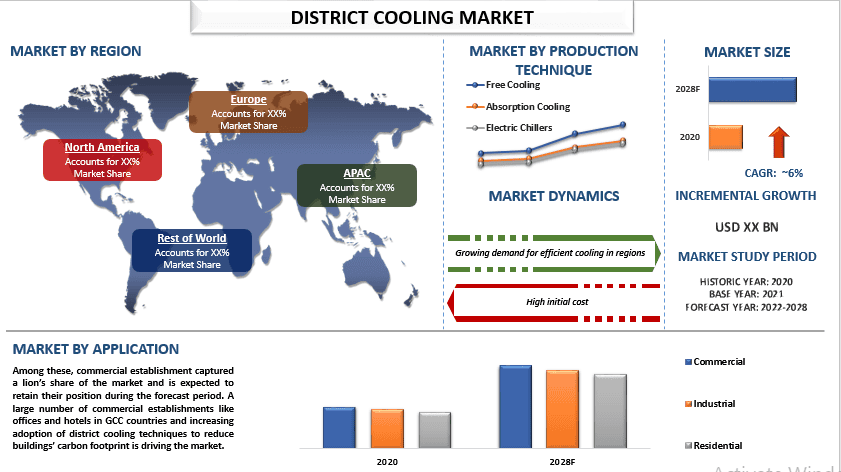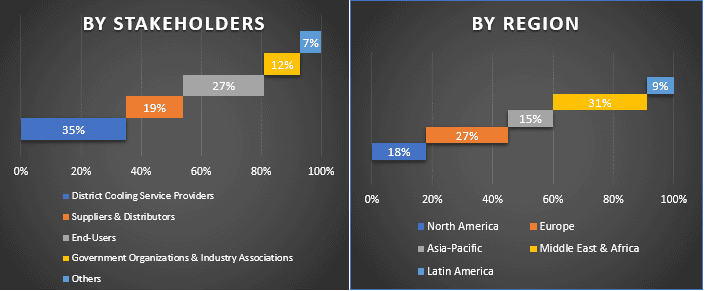- Home
- About Us
- Industry
- Services
- Reading
- Contact Us
District Cooling Market: Current Analysis and Forecast (2022-2028)
Emphasis on Production Technique (Free Cooling, Absorption Cooling, and Electric Chillers); Application (Commercial, Industrial, and Residential); Region and Country

The global district cooling market is likely to showcase a growth of around 6% during the forecast period. Increasing demand for comfort cooling and process cooling in residential and non-residential settings along with commercial benefits and reduction in peak electricity demand provided by district cooling is increasing the number of district cooling projects. It is being implemented worldwide by many kinds of organizations, including investor-owned power utilities, government-owned utilities, privately owned district energy companies, universities, airports, and IT campuses, among others. Besides this, the green building trend across the globe can be more effective if integrated with district cooling systems. Building owners and tenants are demanding higher environmental standards in building design and services. District cooling in combination with building efficiency measures can significantly improve green building certifications, especially when the district cooling system can access waste heat or renewable sources of energy that are unavailable at a single building level. Further, as countries are building smart cities, it is expected that the number of district cooling systems would grow.
Insights Presented in the Report
“Amongst production technique, electric chillers are likely to show positive growth trend”
Based on production technique, the market is categorized into free cooling, absorption cooling, and electric chillers. Among these, the electric chiller category is expected to be widely preferred among the end-users as it provides a reduction in peak electricity demand more efficiently compared to other types. Further, the unavailability of free water is also one of the key factors behind the increasing adoption of electric chillers.
“Amongst application, commercial settings held a prominent position in the market in 2020”
Based on application, the market is categorized into commercial, industrial, and residential. Among these, the commercial establishment captured a lion’s share of the market and is expected to retain its position during the forecast period. A large number of commercial establishments like offices and hotels in GCC countries and increasing adoption of district cooling techniques to reduce buildings’ carbon footprint is driving the market.
“Middle East & Africa stood with significant market share in 2020 ”
For a better understanding of the market adoption of district cooling, the market is analyzed based on its worldwide presence in the countries such as North America (the United States, Canada), Europe (Germany, France, Sweden, Norway, Italy, and Rest of Europe), Asia-Pacific (China, Japan, South Korea, and Rest of Asia-Pacific), Middle East & Africa (Saudi Arabia, The U.A.E., Qatar, and Rest of Middle East & Africa), and Latin America (Brazil, Argentina, and Rest of Latin America). Middle East & Africa is among the leading adopter of district cooling system technology. The hot climatic condition of the region made air conditioning a necessity rather than a luxury. As a result, air conditioning consumes about 50% of the peak power load in the Middle East. This has shifted the regional economies’ focus on district cooling to reduce power consumption which in turn also helps in reducing CO2 emissions. Large construction activities and preference for district cooling systems in new building is boosting the middle east & Africa district cooling market.
Reasons to buy this report:
- The study includes market sizing and forecasting analysis validated by authenticated key industry experts
- The report presents a quick review of overall industry performance at one glance
- The report covers an in-depth analysis of prominent industry peers with a primary focus on key business financials, product portfolio, expansion strategies, and recent developments
- Detailed examination of drivers, restraints, key trends, and opportunities prevailing in the industry
- The study comprehensively covers the market across different segments
- Deep dive country-level analysis of the industry
Customization Options:
The global district cooling market can further be customized as per the requirement or any other market segment. Besides this, UMI understands that you may have your own business needs, hence feel free to connect with us to get a report that completely suits your requirements.
Table of Content
Research Methodology for Global District Cooling Market Analysis (2020-2028)
Analyzing the historical market, estimating the current market, and forecasting the future market of district cooling, three major steps are undertaken to create and analyze its adoption across the globe. Exhaustive secondary research was conducted to collect the historical market numbers and estimate the current market size. Secondly, to validate these insights, numerous findings and assumptions were taken into consideration. Moreover, exhaustive primary interviews were also conducted, with industry experts across the value chain of the industry. Post assumption and validation of market numbers through primary interviews, we employed a bottom-up approach to forecast the complete market size. Thereafter, market breakdown and data triangulation methods were adopted to estimate and analyze the market size of segments and sub-segments of the industry pertains to. Detailed methodology is explained below:
Analysis of Historical Market Size
Step 1: In-Depth Study of Secondary Sources:
Detail secondary study was conducted to obtain the historical market size of district cooling through company internal sources such as annual reports & financial statements, performance presentations, press releases, etc., and external sources including journals, news & articles, government publications, competitor publications, sector reports, third-party database, and other credible publications.
Step 2: Market Segmentation:
After obtaining the historical market size of the district cooling market, we conducted a detailed secondary analysis to gather current market insights and share for different segments & sub-segments for major regions. The major segment is included in the report by production technique and application. Further regional and country-level analyses were conducted to evaluate the overall adoption of district cooling globally.
Step 3: Factor Analysis:
After acquiring the historical market size of different segments and sub-segments, we conducted a detailed factor analysis to estimate the current market size of district cooling. Further, we conducted factor analysis using dependent and independent variables such as the surging need for efficient cooling and rising investment in the infrastructure sector. A thorough analysis was conducted of demand and supply-side scenarios considering the increasing investment, top partnerships, mergers and acquisitions, business expansion, and product launches in the district cooling industry.
Current Market Size Estimate & Forecast
Current Market Sizing: Based on actionable insights from the above 3 steps, we arrived at the current market size, key players in the global market, and market shares of each segment. All the required percentage shares split, and market breakdowns were determined using the above-mentioned secondary approach and were verified through primary interviews.
Estimation & Forecasting: For market estimation and forecast, weights were assigned to different factors including drivers & trends, restraints, and opportunities available for the stakeholders. After analyzing these factors, relevant forecasting techniques i.e., the bottom-up approach were applied to arrive at the market forecast for 2028 for different segments and subsegments across the major regions globally. The research methodology adopted to estimate the market size encompasses:
- The industry’s market size, in terms of value (US$) and the adoption rate of district cooling across the major markets
- All percentage shares, splits, and breakdowns of market segments and sub-segments
- Key players in the district cooling market. Also, the growth strategies adopted by these players to compete in the fast-growing market
Market Size and Share Validation
Primary Research: In-depth interviews were conducted with the Key Opinion Leaders (KOLs) including Top Level Executives (CXO/VPs, Sales Head, Marketing Head, Operational Head, Regional Head, Country Head, etc.) across major regions. Primary research findings were then summarized, and statistical analysis was performed to prove the stated hypothesis. Inputs from primary research were consolidated with secondary findings, hence turning information into actionable insights.
Split of Primary Participants by Stakeholders and Regions

Market Engineering
The data triangulation technique was employed to complete the overall market estimation and to arrive at precise statistical numbers for each segment and sub-segment of the global District Cooling market. Data was split into several segments & sub-segments post studying various parameters and trends in the area of production technique and application of district cooling.
The main objective of the district cooling market study
The current & future market trends of global district cooling were pinpointed in the study. Investors can gain strategic insights to base their discretion for investments on the qualitative and quantitative analysis performed in the study. Current and future market trends would determine the overall attractiveness of the market at a country level, providing a platform for the industrial participant to exploit the untapped market to benefit as a first-mover advantage. Other quantitative goals of the studies include:
- Analyze the current and forecast market size of district cooling in terms of value (US$). Also, analyze the current and forecast market size of different segments and sub-segments
- Segments in the study include the area of the production technique and application of district cooling
- Defined analysis of the regulatory framework for the district cooling industry
- Analyze the value chain involved with the presence of various intermediaries, along with analyzing customer and competitor behaviors of the industry
- Analyze the current and forecast market size of district cooling for the major countries
- Major regions/countries analyzed in the report include North America (the United States, Canada), Europe (Germany, France, Sweden, Norway, Italy, and Rest of Europe), Asia-Pacific (China, Japan, South Korea, and Rest of Asia-Pacific), Middle East & Africa (Saudi Arabia, The U.A.E., Qatar, and Rest of Middle East & Africa), and Latin America (Brazil, Argentina, and Rest of Latin America)
- Company profiles of the district cooling market players and the growth strategies adopted by them to sustain the growing market
Deep dive country-level analysis of the industry
Related Reports
Customers who bought this item also bought










